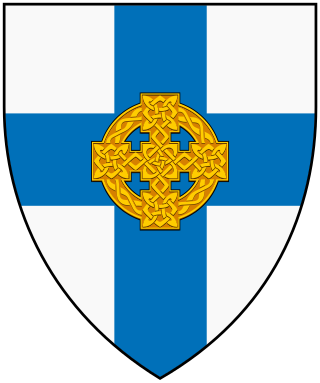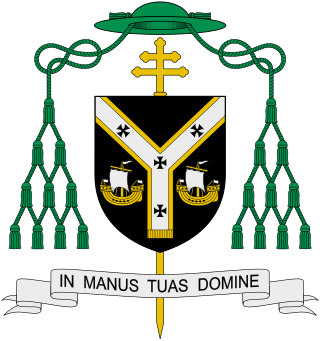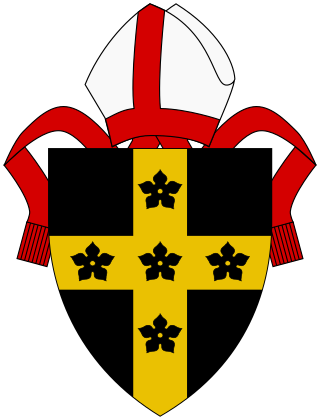
The Church in Wales is an Anglican church in Wales, composed of six dioceses.

The Diocese of Saint Asaph is a diocese of the Church in Wales in north-east Wales, named after Saint Asaph, its second bishop.

The Archdiocese of Cardiff is a Latin archdiocese of the Catholic Church which covers the south-east portion of Wales and the county of Herefordshire in England. The Metropolitan Province of Cardiff therefore covers all of Wales and part of England. Cardiff's suffragan dioceses are the Diocese of Menevia and the Diocese of Wrexham.

Saint Asaph was, in the second half of the 6th century, the first Bishop of St Asaph, i.e. bishop of the diocese of Saint Asaph.

The Bishop of St Asaph heads the Church in Wales diocese of St Asaph.
Elfodd, Elvodug or Elfoddw was a Welsh bishop. He induced the Welsh church to accept the Roman computus for determining the date of Easter endorsed elsewhere in Britain at the Synod of Whitby in 664. This was after centuries of continuing the practice.

Dubricius or Dubric was a 6th-century British ecclesiastic venerated as a saint. He was the evangelist of Ergyng and much of south-east Wales.

St Padarn's Institute came into being in 2016. Until then the site belonged to St Michael's College, an Anglican theological college in Llandaff, Wales. St Michael's college was founded in Aberdare in 1892, and was situated in Llandaff from 1907 until 2016. Among its many alumni was the poet R. S. Thomas. The original building on the site was a house constructed for himself by John Prichard. After his death, that building was incorporated into the newly founded St Michael's College, which was built mainly to the designs of F. R. Kempson between 1905 and 1907. In the late 1950s, a chapel was built by George Pace. The college had significant financial problems in the early 21st century and was eventually closed.

The Cathedral Church of Saints Asaph and Cyndeyrn, commonly called St Asaph Cathedral, is a cathedral in St Asaph, Denbighshire, north Wales. It is the episcopal seat of the Bishop of St Asaph. The cathedral dates back 1,400 years, while the current building dates from the 13th century. The cathedral is part of the Church in Wales and part of the Anglican Communion of Wales.

This article is about the particular significance of the century 1101–1200 to Wales and its people.
John Morgan was a Welsh Anglican bishop. He served as Bishop of Swansea and Brecon, as Bishop of Llandaff, and then also as Archbishop of Wales.

The Bishop of St Davids is the ordinary of the Church in Wales Diocese of St Davids.
Events from the year 1743 in Wales.
David FitzGerald was a medieval Bishop of St David's in Wales.
A clas was a native Christian church in early medieval Wales. Unlike later Norman monasteries, which were made up of a main religious building supported by several smaller buildings, such as cloisters and kitchens, a clas was normally a single building. The building was run by a community of clergy and headed by an abod. Clasau were autonomous and were administered locally.
The Archdeacon of Bangor is the priest in charge of the archdeaconry of Bangor, an administrative division of the Church in Wales Diocese of Bangor. In 1844, the Archdeaconry of Bangor was combined with the Archdeaconry of Anglesey to form the Archdeaconry of Bangor and Anglesey. The archdeaconry comprises the seven deaneries of Archlechwedd, Arfon, Llifon/Talybolion, Malltraeth, Ogwen, Tyndaethwy and Twrcelyn.
This article is about the particular significance of the year 1736 to Wales and its people.
Herewald was a Welsh bishop of Llandaff, who had spent much of his time in England.
Uhtred was a Welsh clergyman. From 1140 to 1148 he was Bishop of Llandaff.